Investments in effective fundraising strategies should be made not despite our need to fund our missions and work, but because of it.
BoardSource, along with our colleagues at the Association of Fundraising Professionals, BBB Wise Giving Alliance, and GuideStar, has developed a new framework for evaluating fundraising effectiveness — one that provides a balanced approach that emphasizes how important it is to invest in strong and sustainable fundraising programs.
Below you’ll find an overview of this new framework. When you’re ready to apply it to your organization, we invite you to download our free toolkit for boards and leadership teams.
Measuring Fundraising Effectiveness: Why Cost of Fundraising Isn’t Enough
There is a lot of attention paid to how nonprofits raise the dollars that they need to support their missions. You don’t have to look far to find news stories and other advisories about organizations that are being accused of spending too much on fundraising.
What’s behind these criticisms?
At the most basic level, they flow from an understanding that organizations exist to fulfill a mission or cause and that funds that are raised in support of that mission need to be spent to achieve it.
With this, we strongly agree.
But they also are rooted in a lack of understanding or appreciation for the role that fundraising plays in most organizations. There’s a widespread sense that fundraising is a necessary evil, and that dollars spent on fundraising are being diverted from the organization’s mission — a belief that responsible organizations spend as little as possible on fundraising.
This is a dangerous misconception and does a disservice to our organizations and our missions.
Why? This orientation to fundraising fails to acknowledge how critically important it is that nonprofits invest in strong strategic fundraising efforts. It encourages organizations to starve their fundraising programs into stagnation, and it encourages donors and the public to compare organizations on the basis of this measure, as though it somehow serves as a proxy for organizational impact, which it most certainly does not.
Investments in effective fundraising strategies should be made not despite our need to fund our missions and work, but because of it.
Given this misguided belief that fundraising expenses are inherently bad, some have begun to argue that it shouldn’t matter how much you spend to raise funds — that percentages are irrelevant, and that it’s all about how much money you are able to dedicate to your mission and work.
But it is possible to spend too much money on fundraising, and we risk eroding the trust between nonprofit organizations and the donors who support us if we ignore that reality.
Championed by
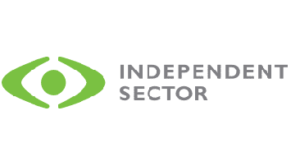
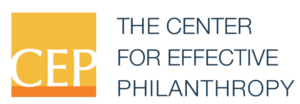

Effective Nonprofits
Emily Davis Consulting
Fund Momentum, LLC
Sort Sol Group
Your Nonprofit Advisor
That’s why we have created what we believe is a responsible and reasonable way of thinking about fundraising effectiveness, which is grounded in the following principles:
- We believe in the work of nonprofit organizations and know that the most important measure of our effectiveness is the impact that we are having in our communities and society as whole.
- We know that charitable support from donors and funders is what makes impact possible, which means fundraising is absolutely mission critical.
- We think that it’s reasonable to expect nonprofits to care about efficiency and return on investment in their fundraising efforts, but that it is not the only way of measuring fundraising effectiveness.
We seek to create a stronger understanding of the role effective fundraising plays in fueling the missions and causes that our organizations serve. We want to support organizations as they evaluate and reflect on their fundraising practices, and communicate to the public what they are doing and why. And we want to do it in a way that respects and honors the critical trust between donors and the organizations and missions they support.
A More Holistic View of Fundraising Effectiveness
While there are many measures that an organization may use internally to evaluate the effectiveness of its fundraising strategy, we propose three primary measures of fundraising effectiveness for both internal and external use, which together, provide a much more complete picture of an organization’s fundraising health.
Total Fundraising Net:
The amount of money available to spend on an organization’s mission as a result of its fundraising efforts. This is the bottom line measure of fundraising success. If it’s not enough to fund the organization’s work, then the other two measures are irrelevant. Here’s how it’s calculated:
Total Amount Raised* — Total Fundraising Expenses** = Total Fundraising Net
Example: If an organization raised $1,000,000 and spent $200,000 on staff and other expenses to do it, its total fundraising net is $800,000 ($1,000,000 – $200,000).
Dependency Quotient:
A measure of risk, the Dependency Quotient measures the extent to which an organization is dependent on its top donors to fund its work. It’s an indicator of how vulnerable the organization could be in the face of changed priorities among its top funders. Generally speaking, organizations would seek to have a lower Dependency Quotient, indicating that they are more resilient to changes in top donor giving. Here’s how it’s calculated:
= Dependency Quotient
Example: If an organization’s top five donors contributed $250,000 during the past three years, and the total organizational expenditures for the same three-year period were $1,000,000, then its Dependency Quotient is 25% ($250,000/$1,000,000), meaning it would have to replace 25% of its budget if it lost its top five donors.
Cost of Fundraising:
A measure of efficiency, the Cost of Fundraising measures how much it costs to raise money within your organization. While some calculate it differently, we measure the average amount that it costs to net one dollar across the entire organization.**** Generally speaking, organizations would seek to have a lower cost of fundraising, indicating they are investing efficiently in fundraising. Here’s how it’s calculated:
= Cost of Fundraising
Example: If an organization spends a total of $50,000 to raise a total amount of $150,000, then its cost of fundraising is 50% ($50,000 / ($150,000 – $50,000)). Or, stated in dollars, it spent $0.50 to net $1.00.
Balancing Risk and Reward
The Tension between Dependency and Cost
Not unlike an investment portfolio, it is very difficult to achieve both a low level of risk (low dependency quotient) and a high rate of return (low cost of fundraising). And that’s because the dependency quotient and the cost of fundraising tend to have an inverse relationship: A low cost of fundraising typically exists alongside a higher dependency quotient, and vice versa.
Why? Because broad-based fundraising efforts — tactics like direct mail campaigns or special events — typically bring in a larger number of low- to mid-level donors and tend to be more expensive because of it. This compares to strategies like major gift or foundation fundraising, which tend to bring in a smaller number of large-scale gifts that cost less but leave you more dependent on them. Here’s how this often plays out across the most common types of fundraising:

That’s why it’s so dangerous for us to use cost of fundraising as the primary measure of fundraising effectiveness. It’s just one piece of the puzzle, and it discourages investment in broad-based fundraising tactics and can actually put the organization at risk. Indeed, when we focus on any one of these measures to the exclusion of the others, we miss the big picture of what a healthy fundraising program is really about.

The organizations with the most strategic and sophisticated fundraising strategies work to build a robust program that balances the risks and rewards of different fundraising tactics through a blended portfolio or strategy. They acknowledge that different fundraising tactics have different strengths, and work to build a cohesive strategy that matures and grows over time.
This is why it’s important to know that whenever you’re looking at an organization’s fundraising effectiveness, you’re looking at a moment in time, which doesn’t tell the story of how an organization might be investing in tactics to yield long-term results. It’s also dangerous to evaluate an organization’s fundraising strategy on the basis of one single tactic — an individual event or fundraising mailing. The interdependencies and building of tactics over time point to the importance of looking at results across the entire strategy or portfolio of tactics and over a reasonable period of time; we recommend three years.
Measuring Fundraising Effectiveness:
A Free Toolkit for Board and Staff Leaders
Download all four Measuring Fundraising Effectiveness resources (.zip file)
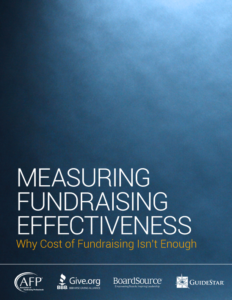
Measuring Fundraising Effectiveness: Why Cost of Fundraising Isn’t Enough
Download
Full Color | Black & White
Discussion Guide
for Board and Staff
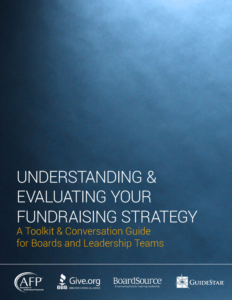
Understanding & Evaluating Your Fundraising Strategy: A Discussion Guide
Download
Full Color | Black & White
Tool to Help You Calculate Your
Fundraising Effectiveness
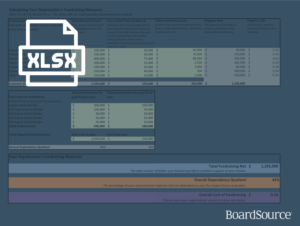
Measure your organization’s fundraising practices; add your information and let the resource do the calculating.
Resource to Help Start the Conversation with Board and Staff

Measuring Fundraising Effectiveness: A Conversation Guide for Board and Leadership Teams
A Broader Conversation about Nonprofit Finances
The challenges that nonprofits face in supporting and sustaining their missions are not limited to a conversation about fundraising and its effectiveness. We acknowledge and thank our colleagues at Bridgespan, the Nonprofit Finance Fund, the National Council of Nonprofits, and many others who are doing important work to help nonprofits and the public better understand the complexities of nonprofit financing, including the importance of understanding the full cost of delivering programs.
Perspectives on Nonprofit Fundraising and Financing
Special thanks to the Evelyn & Walter Haas, Jr. Fund for their support of this project.
*Many organizations have a mix of earned revenue and fundraising (or contributed) revenue. For the purposes of this measure, we are looking at only the total amount raised, which does not include earned revenue.
** Fundraising expenses should include both the costs of the fundraising efforts (event costs, printing, travel, etc.) and the staffing costs associated with those efforts. When Generally Accepted Accounting Principles (GAAP) are followed, joint cost accounting is an appropriate way to handle some fundraising expenses. When using joint cost accounting, organizations should take special care to ensure that they understand the full costs associated with each fundraising tactic and overall fundraising efforts when evaluating the effectiveness of those tactics and strategies.
*** This calculation could be done using any number of “top donors.” We recommend five as a reasonable indicator of level of risk, but this could be adjusted to any reasonable number.
**** Because it’s entirely appropriate for different fundraising tactics to have different average costs of fundraising, it’s important to look at the cost of fundraising across the entire organization versus by individual fundraising tactic. It’s only when you look at things in aggregate that you can assess whether or not — overall — the organization is being efficient with its investments in fundraising. For more on this, read “Understanding & Evaluating Your Fundraising Strategy: A Toolkit & Conversation Guide for Boards and Leadership Teams.”



